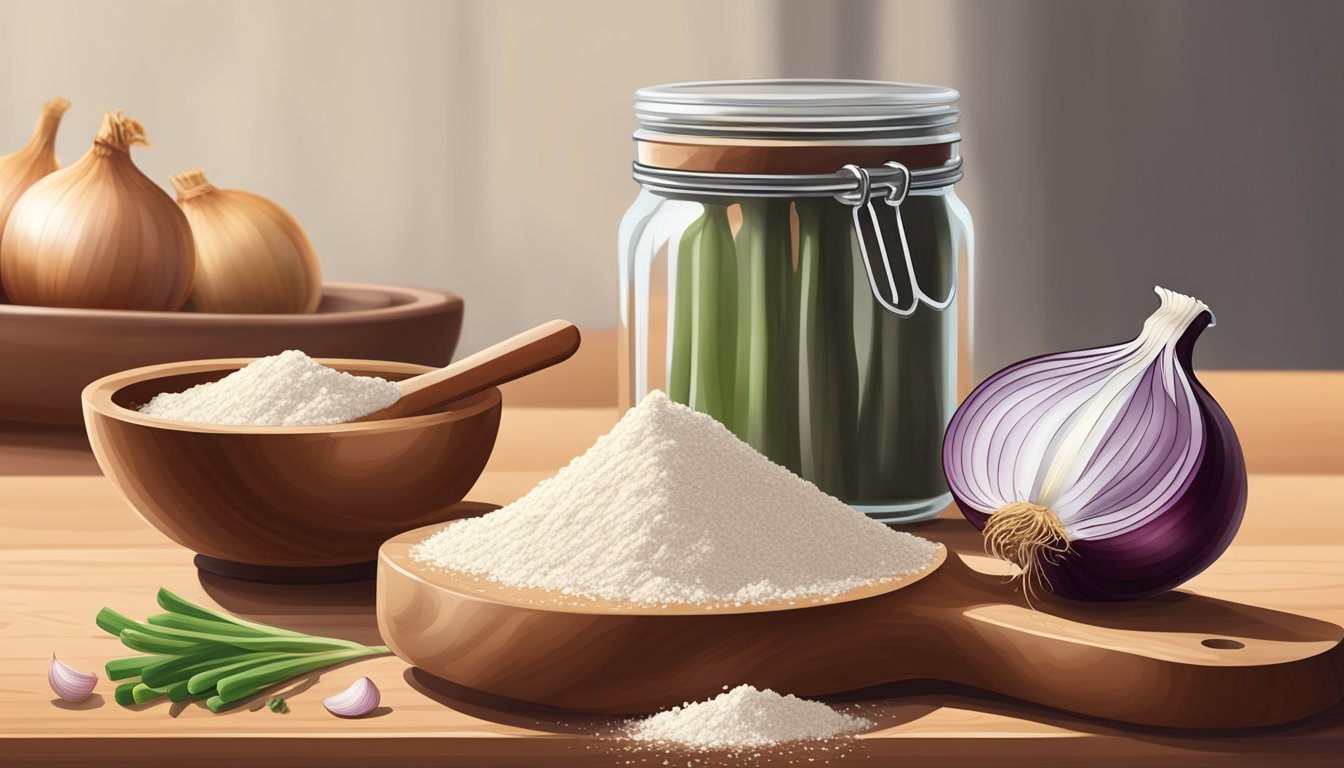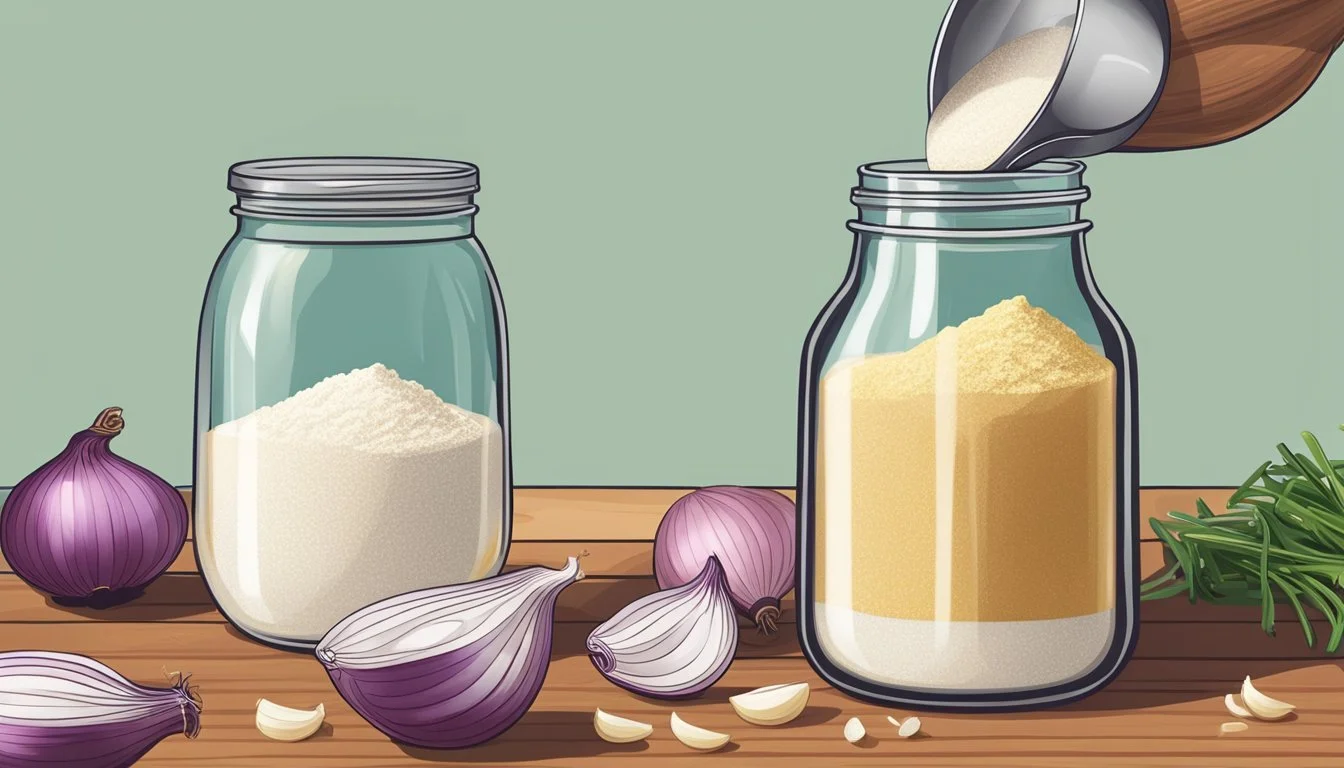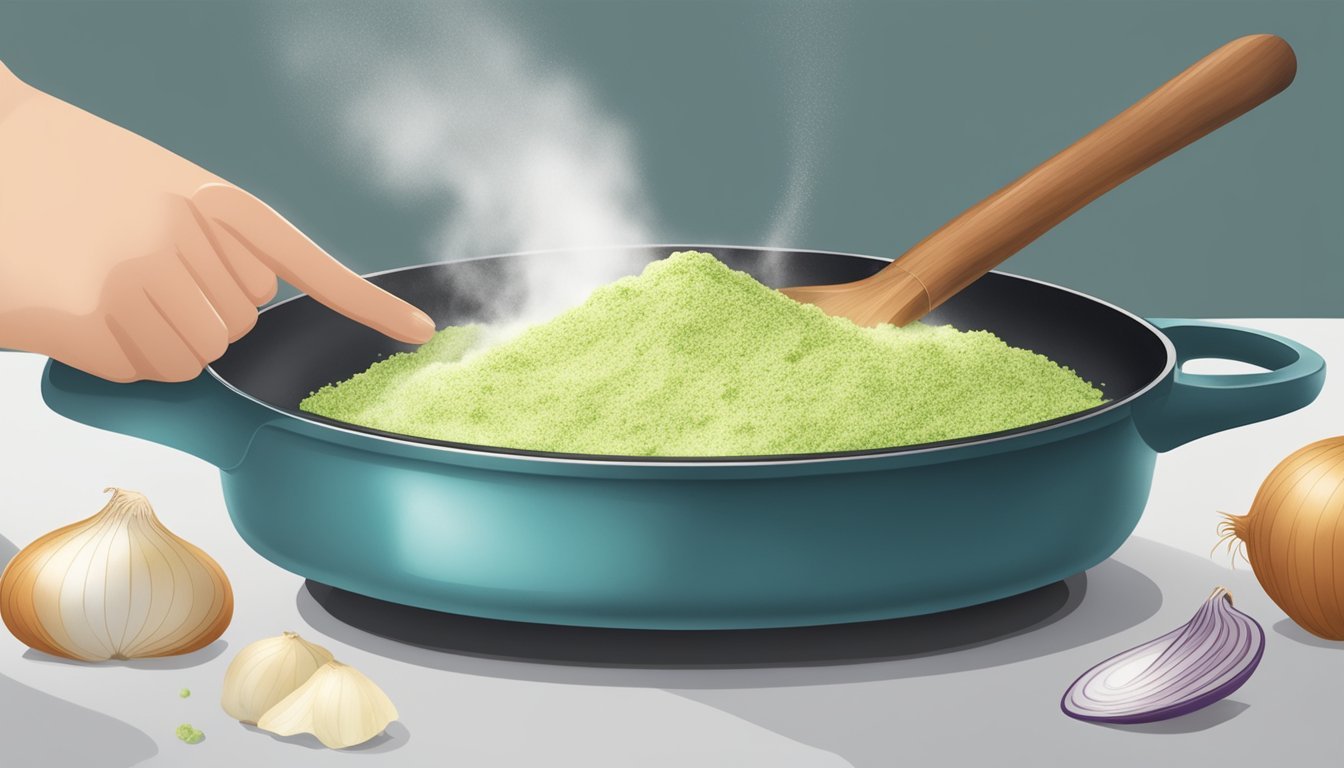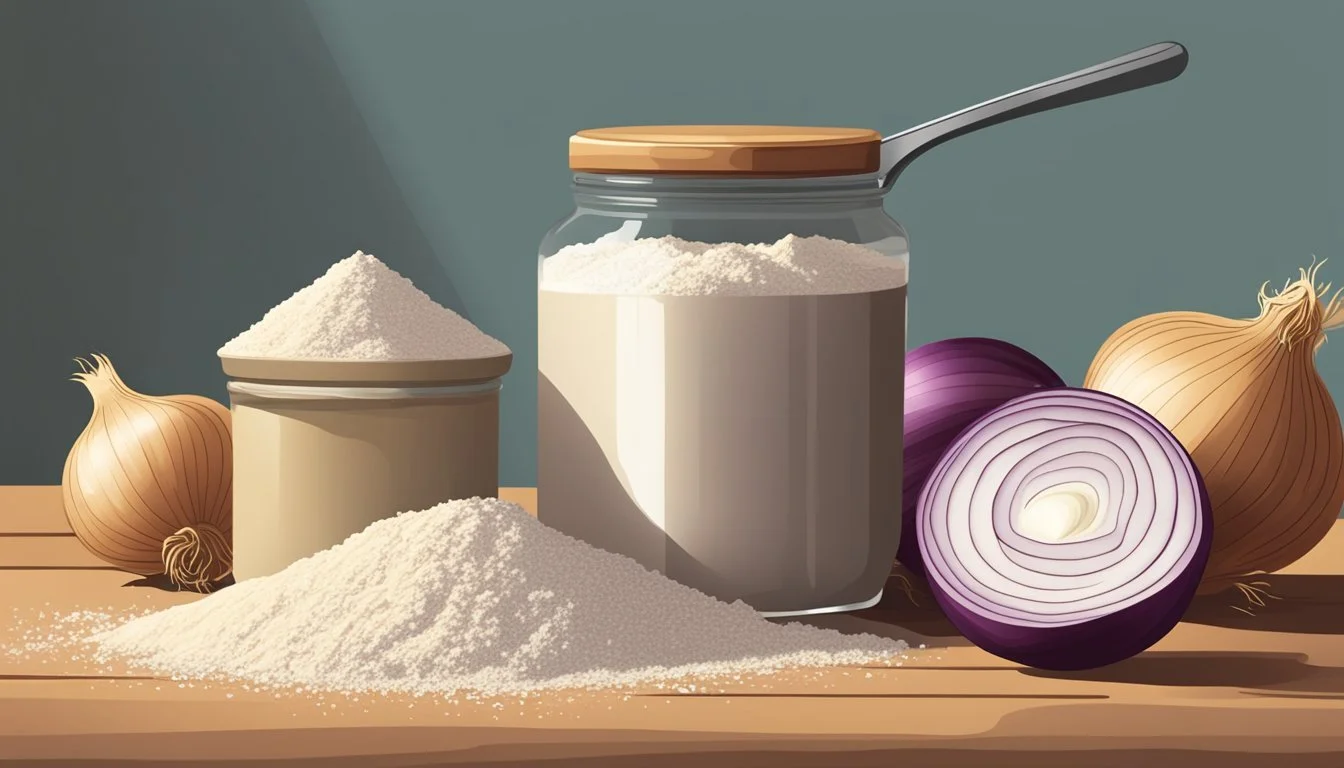How to Substitute Onion Powder for Onions
Simple Measurement Conversion Guide
Onion powder is a pantry staple often used for its convenience and long shelf life. Its potent flavor is derived from dehydrated, ground onions, (What wine goes well with onions?) providing a quick dash of seasoning without the peeling, chopping, and tears associated with fresh onions. In the culinary world, the versatility of onion powder makes it an excellent back-up option when fresh onions are out of reach or when a recipe calls for a milder onion flavor without the additional moisture.
Cooking often requires adaptability, and knowing how to substitute onion powder for onions effectively can save both time and effort. When substituting, it's crucial to consider the flavor intensity and volume differences between the two. Typically, one tablespoon of onion powder can be used as a replacement for one medium-sized onion, although adjustments may be needed based on personal taste and the specific requirements of a recipe.
Incorporating onion powder in dishes that usually call for fresh onions involves a simple conversion, taking into account that the powder will deliver a more concentrated flavor without contributing texture or bulk. This makes it ideal for rubs, soups, and other liquid-based recipes where its characteristics can be fully embraced without significantly altering the dish's intended outcome.
Understanding Onion Powder
Onion powder offers a convenient and concentrated flavor derived from dehydrated onions. It's a staple in many kitchens for its ability to impart onion flavor without the need for fresh onions.
Origin and Production
Onion powder is made from onions that have been dehydrated and then ground to a fine dust. The production process typically involves slicing the onions, drying them out at low temperatures—usually around 120-150 degrees Fahrenheit—to remove the water content, and then grinding the dried pieces into a fine powder. This results in a concentrated product that has a longer shelf life than fresh onions and can be easily stored and used in cooking.
Nutritional Profile
Nutrient Amount per 1 tablespoon (7g) of Onion Powder Calories 20 Water Content None Protein 0.6 grams Sugar 0.9 grams Potassium 70 mg Calcium 15 mg Iron 0.1 mg
Onion powder has a significantly lower water content than fresh onions, which means its nutrients are more concentrated. Although it is low in calories, it nonetheless contributes to the intake of several nutrients, including protein, sugar, potassium, calcium, and iron. It's important to be mindful of the concentrated nature of onion powder when considering its nutritional content compared to fresh onions.
The Substitution Process
Substituting onion powder for fresh onions is straightforward when one understands the correct ratios, the textural outcomes they can expect, and the flavor differences between the two.
Ratio and Measurements
To replace fresh onions with onion powder, one should use the following measurements:
Medium Onion: Approximately 1 cup of chopped onion can be substituted with 1 tablespoon of onion powder.
Large Onion: Around 1 1/2 cups of chopped onion equate to 1 1/2 tablespoons of onion powder.
It's critical to adjust these amounts based on the specific recipe and the intensity of the onion powder.
Considerations for Texture
Onion powder does not provide the same texture as fresh onions. While onions contribute moisture and a crunchy texture to a dish, onion powder is fine and will dissolve, leaving no trace of texture. This distinction should be considered especially in recipes where onions are a key ingredient for texture, such as in salads or as a topping.
Flavor Comparison
There is a flavor variation when substituting onion powder for onions. Onion powder offers a concentrated, somewhat sweet onion flavor without the sharpness of raw onions. It's an excellent choice for flavoring dishes like soups, sauces, and stews, where it blends seamlessly. However, if the dish relies on the crisp, pungent flavor of raw onion, adjusting other seasonings might be necessary to achieve the desired taste profile.
Common Substitutes for Onion Powder
When fresh onion powder isn't available, a variety of other ingredients can serve as effective replacements. Each substitute varies in flavor and preparation, offering unique characteristics to a dish.
Using Fresh Onions
In recipes, fresh onions are the most direct substitute for onion powder. They bring a similar basic flavor profile but with added moisture and texture. It's important to consider the volume difference:
One tablespoon of onion powder is roughly equivalent to one medium-sized fresh onion.
Other Dehydrated Options
Various dehydrated onion products can replicate the convenience and concentrated flavor of onion powder:
Onion flakes: When ground, can be used in a 1:1 ratio with onion powder.
Onion salt: A blend of onion powder and salt, where half the intended amount of onion powder should be replaced by onion salt to avoid over-salting.
Herbs and Vegetables Alternatives
A range of herbs and vegetables can be used as a replacement, each introducing a different flavor note:
Garlic powder: Adds a different but akin taste; use a 1:1 ratio as an onion powder substitute.
Shallots, leeks, and scallions: These can offer a milder taste and should be used finely chopped in the dish.
Chives and fennel bulbs: Provide a more herb-like and slightly sweet onion flavor when used as a fresh garnish or included during the cooking process.
Celery: (how long does celery last?) While not onion-flavored, it can contribute a complementary savory note when onion powder is not critical to a recipe's flavor profile.
The user should consider the desired outcome of their dish when selecting an onion powder substitute, as each option will impart a different flavor and texture to the food.
Culinary Applications
When substituting onion powder for fresh onions in cooking, it's essential to consider the dish's desired flavor intensity and texture. Onion powder works best in recipes where a smooth consistency is preferred.
Recipes Favoring Onion Powder
Certain recipes benefit from the fine texture and concentrated flavor of onion powder. It excels in dressings and marinades where a smooth, non-chunky base is paramount. Additionally, it's ideal for spice rubs, blending seamlessly with other spices and seasonings for a consistent coating on meats. Onion powder shines in soups and stews where it melds with the liquid, providing a uniform onion presence without the bulk of fresh onions.
Dips: Contributes a subtle onion flavor without altering the dip's texture.
Salads: Enhances dressings, especially when a creamy or vinaigrette consistency is desired.
Dry Spice Mixes: Easily incorporated for even distribution of flavor.
Adjusting Seasonings and Spices
When fresh onions are replaced with onion powder, it's important to adjust the quantity to avoid overpowering the dish. A general guideline is to use:
Fresh Onion Onion Powder 1 small onion 1 teaspoon 1 medium onion 1 tablespoon 1 large onion 1 1/2 tablespoons
Beyond the basic substitution, chefs should taste and adjust, bearing in mind the increased potency of spices and seasonings when using onion powder. Balance is key in sauces, so add onion powder in incremental amounts. In vegetables, it can be sprinkled lightly to enhance without dominating.
Soups and Stews: Start with a small amount and season to taste.
Vegetable Dishes: A pinch can elevate sautéed or roasted vegetables. (What wine goes well with roasted vegetables?)
Sauces and Dressings: Whisk in cautiously and sample frequently.
Remember that onion powder can intensify as it cooks, so restraint is often wise in initial seasoning.
Storing and Handling Onion Powder
Proper storage of onion powder extends its shelf life and preserves its potency for cooking use, making it an essential aspect of kitchen management.
Shelf Life and Optimal Storage
Onion powder typically has a shelf life of two to three years if stored correctly. Optimal storage involves placing the powder in a:
Cool: Shielding it from heat sources.
Dry: Ensuring low humidity to avoid clumping.
Dark: Protecting it from light, which can degrade its quality over time.
The pantry is the ideal storage location, offering a consistent, ambient environment. Glass containers with airtight seals are recommended over plastic, as they better preserve flavor and prevent moisture absorption. While refrigeration is not necessary, it can be considered if a pantry is not available, as long as the container is sealed to prevent condensation.
Storage Factor Onion Powder Requirement Temperature Cool (Room temperature) Humidity Dry (Low humidity) Light Exposure Dark (Minimal to no exposure) Container Glass with an airtight seal
It is not advisable to freeze onion powder, as freezing can introduce moisture upon thawing, which may lead to spoilage.
Homemade Onion Powder Preparation
To make your own onion powder:
Start with fresh onions.
Peel and thinly slice the onions.
Blanching is not necessary, despite some sources recommending it.
The key to homemade onion powder lies in proper dehydration:
Temperature: Dry the onions at a low temperature of 120-150 degrees Fahrenheit.
Time: Dehydration can take anywhere from 6 to 10 hours.
Indicator: The onions should be very brittle once fully dehydrated.
Once dried, the onions must be ground to a fine powder. To ensure longevity, one should store homemade onion powder by the same measures as store-bought: in an airtight glass container, kept in a cool, dry, and dark place within the pantry. Homemade powder might have a shorter shelf life compared to commercial products, so it's advised to make it in smaller batches for regular use. Dried onion flakes can also be prepared in a similar manner, providing an alternative texture suitable for different cooking applications.
Enhancing Dishes with Onion Powder
Onion powder is a potent spice that elevates a simple dish to a savory masterpiece. Its concentrated flavor is key in various culinary applications, from seasoning meats to enriching sauces.
Versatile Uses in Cooking
Onion powder shows its versatility through its ability to season meats effectively. It is especially beneficial for those who enjoy seasoning meat before cooking. For instance, when one wants to prepare hamburgers, incorporating a teaspoon of onion powder into the meat mixture can significantly enhance the overall flavor profile.
Eggs: Sprinkle onion powder onto eggs, whether they are scrambled or in an omelet, for a pop of onion flavor without the additional moisture that fresh onions would contribute.
Dry Rubs: It serves as an excellent base for dry rubs, adding depth to the taste of grilled or roasted meats.
Casseroles: A dash of onion powder can deepen the flavor layers in a casserole, ensuring each bite is rich in umami.
Savory Dishes: From soups to gravies and beyond, onion powder can be the secret ingredient that rounds out the taste of any savory dish.
By considering onion powder as a primary spice, cooks can create dishes with a full-bodied taste that satisfies the palate.
Creating Unique Flavor Combinations
The ability to enhance recipes with unique flavor combinations sets onion powder apart as a culinary staple. Savory dishes, in particular, benefit from its addition:
Popcorn Seasoning: A sprinkling of onion powder on popcorn imparts an irresistible savoriness, making it a popular homemade seasoning choice.
Onion Dip: When mixed with sour cream or yogurt, onion powder quickly transforms into a delightful onion dip perfect for chips or vegetable sticks.
Scramble: It's not just eggs alone; any breakfast scramble with vegetables or cheese will have its taste lifted with a pinch of onion powder.
Moreover, onion powder pairs well with other spices, allowing chefs to craft a unique blend of flavors that can make a dish stand out. By experimenting with various combinations, one may learn how onion powder can complement or enhance different ingredients within a recipe.
DIY Onion Alternatives
Creating DIY alternatives to onion powder can be both a fun and simple process, allowing more control over flavor balance and ingredient quality. Home cooks can dehydrate their onions into flakes or create a flavorful onion paste directly from fresh onions.
Making Onion Flakes
One can make onion flakes by thinly slicing chopped onions and spreading them on a baking sheet. It's critical that the slices are uniform to ensure even dehydrating. The oven should be preheated to the lowest temperature setting, typically around 150 degrees F. The slices need to be dried until they're brittle, which typically takes several hours. Once the drying process is complete, a food processor can be used to pulse the dehydrated onions into flaky consistency. It's essential to store these flakes in an airtight container to maintain freshness.
Crafting Onion Paste
To create onion paste, one can take fresh chopped onions and use a food processor to blend them into a smooth paste. The key to a good onion paste is to achieve the right consistency without making it too watery. To do this, one may need to pulse the onions and scrape down the sides of the bowl periodically. This paste can be frozen in small quantities, such as ice cube trays, to easily thaw and use in future servings. Additionally, one might consider adding chopped chives to the paste for a more complex flavor profile. Once again, proper storage is crucial, and freezing can help maintain the balance of flavors.
Nutritional Adjustments
When substituting onion powder for onions, one must consider the nutritional changes this substitution will bring to the dish. This includes evaluating calorie content and the presence of minerals such as potassium, calcium, and iron.
Low-Calorie Options
Onions provide a low-calorie option that can increase the volume of a meal without significantly raising its calorie count. Onion powder, on the other hand, is more calorie-dense due to its dehydrated form. For calorie-conscious cooks, it is important to consider that a tablespoon of onion powder has significantly more calories than a tablespoon of fresh onion.
Fresh Onion:
Calories: ~16 per 1/4 cup
Protein: ~0.36 grams
Onion Powder:
Calories: ~24 per tablespoon
Protein: ~0.68 grams
Boosting Mineral Content
While the dehydration process concentrates some nutrients, it may not necessarily pertain to all minerals. Fresh onions typically contain small amounts of minerals that may be lost when dehydrated into powder form. However, there are several ways to boost the mineral content when using onion powder. For instance, incorporating celery seeds can add calcium and iron, and using a small amount of vinegar in a recipe can provide potassium. Consider these additions to ensure that the dish maintains its nutritional value.
Onion Powder Additions:
Celery Seeds:
Calcium: Good source
Iron: Contains non-heme iron
Vinegar:
Potassium: Can contribute to daily intake
In summary, adjusting recipes to compensate for the nutritional differences between fresh onions and onion powder is feasible. Paying attention to calorie content and the mineral profile of ingredients can ensure that meals remain balanced and nutritious.
Creative Uses Beyond Cooking
Onion powder is not just a staple in the kitchen for dishes like roasted vegetables, French onion soup, or seasoning meats; it's also versatile enough to be used in several non-culinary contexts.
Onion Powder in Home Remedies
In home remedies, onion powder often serves as a homeopathic component. For example, dried onion flakes can be compacted into a poultice to help alleviate minor aches and pains. Due to its purported anti-inflammatory properties, onion powder can be mixed into a paste with water and applied directly to the skin in a thin layer, potentially offering a natural solution for soothing irritations.
Seasoning Non-Culinary Items
In non-food contexts, onion powder can be used creatively to season and deodorize:
Season Meat-Scented Candles: Crafters can mix granulated onion into wax to create meat-scented candles, appealing to those who enjoy the aroma of cooking meats.
Potpourri Additive: A pinch of onion powder can provide a surprising, earthy undertone to a homemade potpourri blend, offering a bold contrast to traditional floral scents.
Compelling uses beckon beyond the culinary horizon, representing how one might maximize their pantry for multiple aspects of daily life. Onion powder's versatility shines through in these innovative applications.
Conclusion
When substituting onion powder for fresh onions, cooks should consider both the recipe's requirements and the flavor profile intended. Onion powder is more potent than fresh onions and should be used in smaller quantities. As a general guideline, one tablespoon of fresh onion is roughly equivalent to 1/4 teaspoon of onion powder.
For dishes that benefit from the texture and bulk provided by onions, this substitution may not be appropriate. However, in soups, stews, and other liquid-based recipes, onion powder can easily integrate to impart a similar onion flavor without the additional volume.
In cases where onion powder is unavailable, alternatives such as garlic powder, shallots, or leeks might be utilized, always bearing in mind the necessity to adjust quantities accordingly. To maintain the balance of flavors in a recipe, it is crucial to consider the potency of these substitutes and modify additional seasonings, such as salt, to taste.
Here's a quick reference for substituting onion powder for fresh onions:
Fresh Onion Quantity Onion Powder Equivalent 1 tablespoon 1/4 teaspoon 1/4 cup 1 teaspoon 1/2 cup 2 teaspoons 1 cup 1 tablespoon
This concise conversion chart offers an easy way to swap fresh onions with onion powder. Cooks should remember to start with less and adjust upward as taste dictates, ensuring successful integration of onion powder as a substitute without compromising the dish's flavor integrity.







